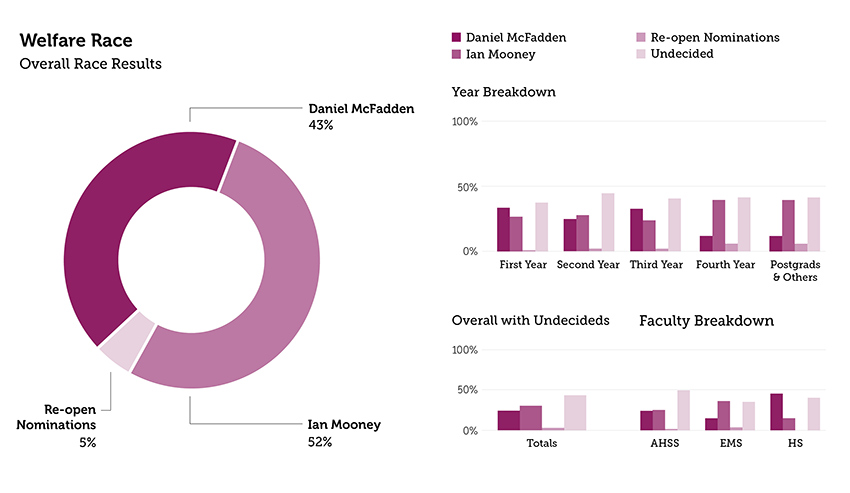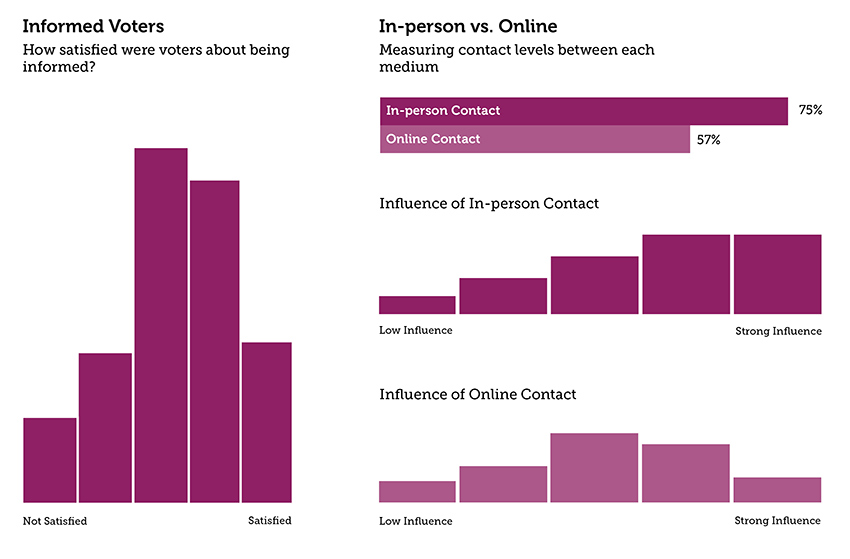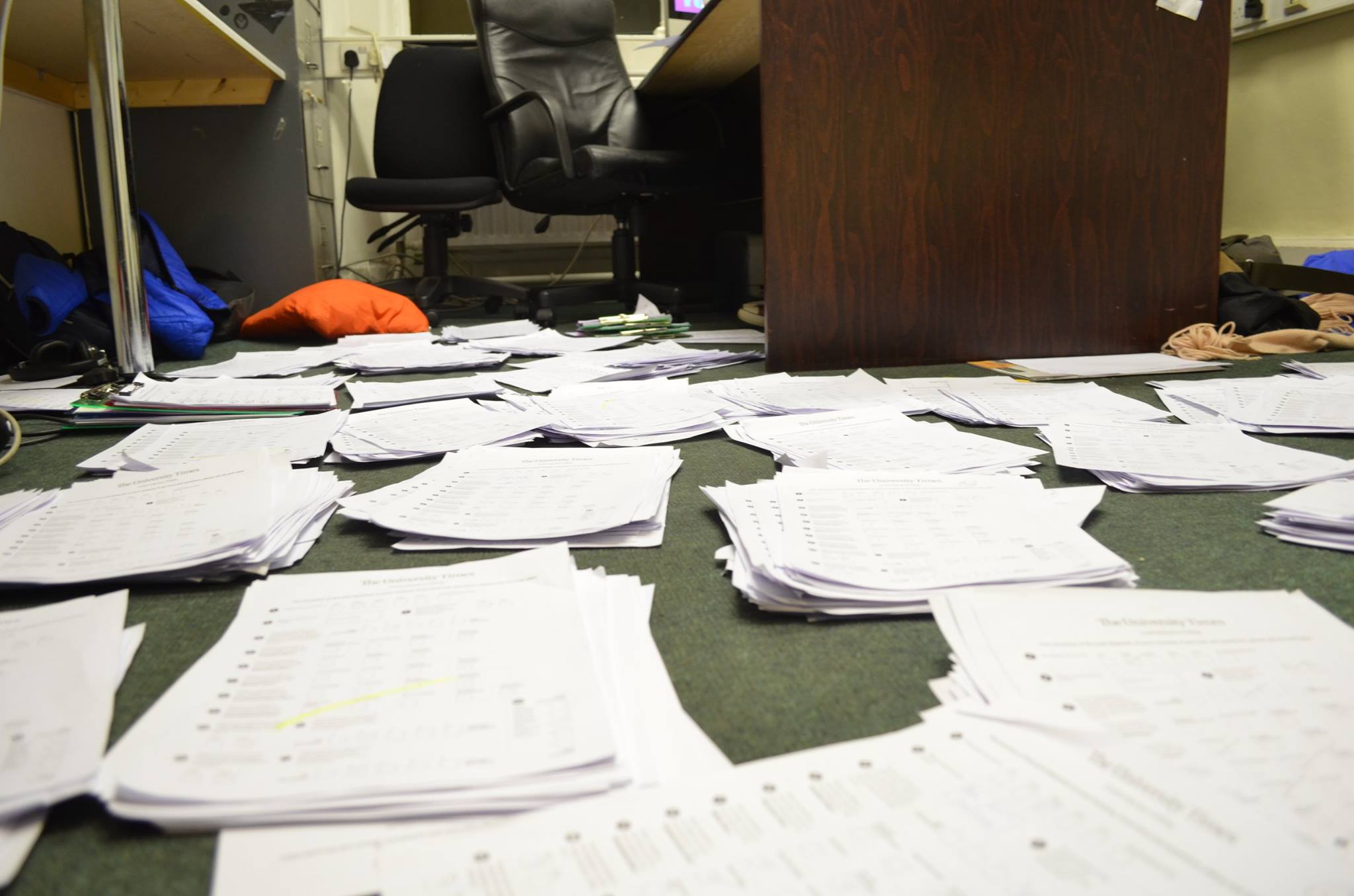Leanna Byrne, Edmund Heaphy & John Keating | Editor, Creative Director & Staff Writer
The University Times poll was conducted on Thursday and Friday in the Arts Block, the Hamilton, the Buttery, the GMB, the SU Café, D’Olier Street and St James’. Over the two days 1,131 students were polled about candidates, informed voting and interaction with campaigns.
According to the data collected, McGlacken-Byrne, Byrne, Riggs and Murphy are favourites among the voters. The Welfare Race sees Mooney ahead of McFadden by 9 per cent, but with high levels of undecided voters and tight margins in the breakdown, voter turnout might be the deciding factor in this race.
President
“Domhnall McGlacken-Byrne looks set to run away with the two-horse Presidential Race”
Domhnall McGlacken-Byrne looks set to run away with the two-horse Presidential Race with 76 per cent of 1,131 students polled saying that they will be voting for the candidate this week. Jasper Pickersgill received 19 per cent of voter’s number one preferences and 5 per cent of students intend on voting to ‘Re-open Nominations’.

McGlacken-Byrne tops the polls across all years and faculties according to The University Times election poll results. The candidate is most popular among third year students as 82 per cent indicated their preference to give him their number one. Pickersgill received his highest percentage with first years at 28 per cent, but McGlacken-Byrne overtakes him with a solid 71 per cent. Seventy-nine per cent of second year students said they will be voting for McGlacken-Byrne and 17 per cent for Pickersgill. Undecideds are highest amongst fourth years (47%), fifth years and postgraduates (66%). However, without taking this group into consideration leaves McGlacken-Byrne in a strong leading position.
Results were also broken down by faculty, which show similar trends for the McGlacken-Byrne campaign. 73 per cent of students from the Arts, Humanities and Social Sciences (AHSS) faculty say they are voting for McGlacken-Byrne and 24 per cent for Pickersgill. The same can be seen with 72 per cent for Engineering, Mathematics and Science (EMS) students voting for McGlacken-Byrne and 20 per cent for Pickersgill. With Health Science (HS) students McGlacken-Byrne has the undeniable advantage as 88 per cent from this faculty will be voting for their HS Convenor.
Education
Uncontested candidate in the Education Race, Katie Byrne, is set to get into office safely with 85 per cent of voters polled set to put her ahead of RON.

In the breakdowns according to year, Byrne is especially popular with second year students as 89 per cent of voters say they are giving her their vote. Fifth year and postgraduate students represented the highest undecided vote at 69 per cent.
Across faculties Byrne received 84 per cent in both the AHSS and HS faculties. Her own faculty, EMS, gave her a 90 per cent top of the polls.
Welfare
Mooney has pulled ahead of Daniel McFadden in the Welfare Race by 9 per cent. The results showed that 52 per cent of students will be voting Mooney and 43 per cent of students for McFadden. Preference for ‘Re-open Nominations’ (RON) was low as only 5 per cent of students opted for this option.

However, with the inclusion of students who are ‘undecided’ makes this race even tighter as 43 per cent of students ‘don’t know’ who they will be voting for in welfare this week. This may indicate that there will be a high percentage of those polled that will not be voting, but as Mooney (29%) only beats McFadden (24%) by 5 percentage points when undecideds are included this race could come down to how many each team is able to drag to the polls.
“There is very little between the candidates in the AHSS faculty as 47 per cent of students say they are voting for McFadden and 49 per cent for Mooney.”
According to the breakdown by year, McFadden is popular amongst first year students as 55 per cent of first year students polled intend to vote for Dan, giving him an 11 per cent lead over Mooney (44%). Ian Mooney is the narrow favourite among second year students with 51 per cent, just 5 per cent ahead of McFadden (46%). Among fourth years and postgraduate students Mooney sits in a comfortable position with 68.8 per cent of fourth years and 62.5 per cent of fifth years and postgraduates intending to vote Mooney for welfare. Only 20 per cent of fourth years and 13 per cent in the postgraduate/other category said they will be voting for McFadden. That said, McFadden shows a clear lead in his own year coming in at 56 per cent, whereas Mooney falls behind at 41 per cent.
Unsurprisingly, 85.5 per cent of students in the Engineering, Mathematics and Science (EMS) faculty intend on voting for Mooney, their faculty convenor. McFadden has the edge in the Health Science (HS) faculty at 75 per cent. There is very little between the candidates in the Arts, Humanities and Social Sciences (AHSS) faculty as 47 per cent of students say they are voting for McFadden and 49 per cent for Mooney.
Across all years and faculties students that remain ‘undecided’ range from 35 to 75 per cent. As mentioned previously, this could be an indicator of poor voter turnout, but can also leave this race open to the events of the four days of voting.
Communications
Sixty-five per cent of voters are expected to vote for Samuel Riggs in the Communications Race this week according to the results from The University Times Election poll. PJ Moloney is expected to receive 22 per cent of the vote and RON 13 per cent.

“This indicates a failing on both candidates’ parts to reach out to the student voters.”
Although the results showed a comfortable position for Riggs, when ‘undecideds’ are taken into consideration, our poll reveals that 57 per cent of students do not know who they will be voting for in the Communications Race. With undecideds included in the overall breakdown, the percentage difference between each candidate narrows: only 31 per cent of students will vote for Riggs and 10 per cent will vote for Moloney. This indicates a failing on both candidates’ parts to reach out to the student voters.
The Story of the Undecideds
The number of undecided students remains steady in all year groups except for the “Postgraduate & Others” group, which includes fifth-year students. The highest number of undecided voters are found in the Communications Race, which has an undecided rate more than than percentage points higher than every other race.
In terms of the year-by-year breakdown, Riggs runs away with first year students with 77 per cent compared to Moloney who stands at 19 per cent. Riggs also beats Moloney with second and third year voters with 74 per cent and 79 per cent respectively. Twenty-three per cent of second year voters and 15 per cent of third years said they were voting Moloney. The two candidates are tied in Moloney’s own year as each candidate is expected to receive 47 per cent of the fourth year vote. At postgraduate level, Riggs steals ahead at 57 per cent to Moloney’s 43 per cent. However, undecideds are at a high 72 per cent for these students.
Faculty breakdown shows Riggs ahead in each faculty, particularly for Health Science students at 79 per cent. Seventy-one per cent of EMS students say they are voting for Riggs and 20 per cent for Moloney. In the AHSS faculty Moloney fairs better at 24 per cent, but Riggs remains at a steady 69 per cent.
Entertainment
The University Times Election Poll results show that just over half of students polled will be voting Finn Murphy for Ents. Overall results from students polled see Aleksandra Giersz receiving 18 per cent of votes, Finn Murphy 52 per cent and Ben Ó Mathúin 25 per cent. Five per cent of students will opt to ‘Re-open Nominations’.

Being at Home in your Faculty
In the majority of races, candidates poll significantly better in their home faculty. For example, in the President Race, Domhnall McGlacken-Byrne polls significantly better in the Health Sciences Faculty. In the Welfare reace, Ian Mooney polls strongest in the Engineering, Mathematics and Science Faculty. Both candidates are Faculty Convenors. This is important in a particularly close race, and this is where Mooney’s marginal lead comes from.
This race seems to be decided as Murphy is the favourite across all years and faculties, with Ó Mathúin only coming close with second years at 38 per cent to Murphy’s 45 per cent lead. Forty-eight per cent of first year voters intend to vote Murphy, 30 per cent for Ó Mathúin and 21 per cent for Giersz. In third year, 61 per cent of voters polled said they will be voting for Murphy, 19 per cent for Giersz and 11 per cent for Ó Mathúin. The percentage remains at 61 per cent for Murphy for fourth year voters, while 27 per cent said they were voting for Giersz, 10 per cent RON and 2 per cent for Ó Mathúin. Although Murphy has the edge with postgraduate and fifth year students, the spread is quite close due to a large amount of undecided voters (63%).
Interestingly, Giersz is second to Murphy amongst AHSS students. Murphy is expected to receive 40 per cent of the vote, while Giersz should bring in 31 per cent and Ó Mathúin 23 per cent. With EMS, Ó Mathúin comes in second with 32 per cent, Giersz at 13 per cent and Murphy ahead at 52 per cent. Similar trends show with HS students, with 55 per cent of voters preferring Murphy, 23 per cent for Ó Mathúin and 19 per cent for Giersz.
How informed are voters?
The University Times Election Poll asked voters how satisfied they are that they will be able to make an informed decision based on the information presented to them. Overall the results show a positive trend as 29 per cent of voters gave a ‘four’ and 33 per cent a ‘three’ on a scale of one to five, with ‘one’ being ‘very dissatisfied’ and ‘five’ ‘very satisfied’.
Voters in third year represented the group most confident of their informed decision as 21 per cent gave a ‘five’ and 29 per cent a ‘four’ on our scale. Postgraduate students had the highest percentage of voters saying they were ‘very dissatisfied’ at 28 per cent, but had a neutral position overall with 38 per cent at postgraduate level giving a ‘three’ on the scale.

Campaign Influence
The University Times also set out to measure how candidates influence their voters by comparing interactions in person and via social media. According to the results, online presence has very little influence compared to in-person contact with either candidates, campaigners or by listening at hustings.
“According to the results, online presence has very little influence compared to in-person contact with either candidates, campaigners or by listening at hustings.”
From the 1,131 students polled 43 per cent of students say they have had no interactions with campaigns via social media (Facebook, Twitter, etc.). Those that said they had interactions through social media were then asked about the strength of that influence on how they will vote. On a scale of one to five, with ‘one’ representing ‘no influence’ and ‘five’ a ‘strong influence’, the majority of those influenced indicated a neutral position at ‘three’ (19%), followed by 16 per cent at ‘four’, 10 per cent at ‘two’, 7 per cent at ‘five’ and 6 per cent at ‘one’. Breakdown of students by year also sees ‘three’ being the most prefered option for voters that indicated they have had any social media interaction. Those at postgraduate level indicated the highest level of no contact through social media at 71 per cent.
In comparison, 75 per cent of students polled have said that they have had ‘in-person’ contact with candidates and campaigners over the past week. Again, voters were asked to measure the level of influence this had over their decision at the polls on a scale of one to five, with ‘one’ having ‘no influence’ and ‘five’ a ‘strong influence’. Twenty-two per cent of voters indicated their influence as a ‘four’, followed by 21 per cent at a ‘five’’. Sixteen per cent of voters adopted a neutral position at ‘three’, 10 per cent at ‘two’ and 5 per cent at ‘one’.
Despite in-person contact being the most influential factor for campaigns according to data collected, personal contact is low among fourth years, fifth years and postgraduates.







